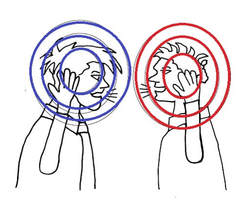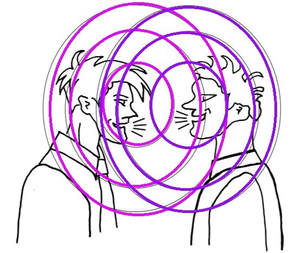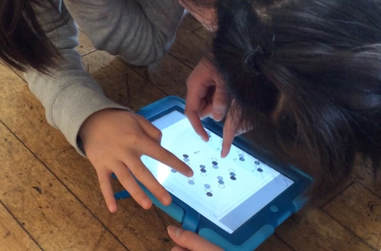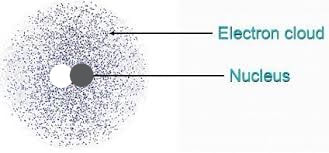Defining thinking is inevitably difficult because thinking is already implied behind the action of defining. The task of understanding thinking is a bit like the short cartoon above in which the Pink Panther sucks himself up entirely in a vacuum cleaner that he himself is holding – this sucking yourself up in your own vacuum cleaner move is not really possible but we enjoy imagining it as if it was possible.
When people write and talk about ‘teaching thinking’ they do not just mean teaching any and all types of thinking because some thinking is obviously quite bad. They mean teaching ‘good thinking’ which they might call ‘intelligence’ or ‘higher order thinking’ or some other technical sounding term which always really translates most accurately as ‘the kind of thinking that we do not think we see enough of and that we want to see more of’. Of course this kind of thinking changes over time. It is plausible that Plato and other ancient Greeks valued formal logical reasoning so much precisely because there was not much of it around and it was very hard for humans to do. Now there are computers who can do that sort of thing for us we tend to value creative reasoning more. In 1987 Lauren Resnick reported that the kind of thinking that teachers of thinking valued was characterised by complexity, nuance, multiplicity, uncertainty and surprise by which they meant that they could not say for sure in advance what good thinking was but they recognised it when they saw it (Resnick, 1987).
In order to try to account for the nature and origin of the complex and surprising thinking that we value and want to teach more of, dialogic theory puts forward the metaphor of thinking as embodied dialogue. Educational research has confirmed that the metaphor of thinking as dialogue is a fruitful one. This metaphor lies behind programmes that have been successful at teaching thinking (Resnick et al, 2015). Bakhtin’s clarification that dialogue occurs only when answers give rise to new questions (Bakhtin, 1986) is useful and suggests that the ‘dialogic’ nature of dialogue refers to dynamic mutual illumination and inter-animation across a gap of difference (Wegerif, 2011).
Considering what is wrong with some of the other metaphors for thinking provided by cognitive psychology can help us to understand the potential value of the metaphor of thinking as dialogue. Behaviourism gave us a metaphor of thinking as ‘nothing but talking to ourselves’ producing sub-vocalisations that can be measured as behaviour (Watson, 1958), cognitivism violently replaced behaviourism with the metaphor of thinking as nothing but information processing (Pinker, 1999) and now I hear it is hard to get a job in a psychology department unless you can scan brains and the new metaphor of thinking is nothing but neural activity. These various metaphors or lens have all proved insightful in different ways. The problem with them arises from their ‘nothing but’ nature. Dialogic theory says that the ‘truth’ of something complex like ‘thought’ is unlikely to be found in any one metaphor or model but is something that we can best move towards when we have a variety of different metaphors in dialogue with each other. This is the polyphonic version of truth put forward by Bakhtin (Bakhtin, 1991). It also, interestingly, lies behind the new transdisciplinary understanding of how best to make progress in science (Nowotny, 2004).
Dialogue as a metaphor for thinking is both specific and general. Specifically it draws attention to and promotes real concrete face to face dialogues in classrooms when the thinking is found in the speaking or other embodied semiosis. The way that small groups work together to solve problems and to pose problems is already thinking (Woolley et al 2010: Stahl, 2009). The way in which cultures, societies and communities respond to challenges and design together for a collective future is also thinking (cf Dewey on the importance of ‘social intelligence’ 1993, p104).
The word ‘teach’ comes from an old German root ‘tǣcan’ which means to point out. Teaching is about pointing things out. It is only possible to point things out in the context of a relationship where you can follow my gaze and I can follow yours. So teaching involves first building a relationship and then directing the attention of students within the context of that relationship.
If we want to teach thinking then the most important thing to point out is ignorance: just how much we do not know. Rather than simply being a model for ignorance, by asking questions a teacher can serve as a model for curiosity.
Teaching questioning
People might say that questions are always asked in a context and are always questions about something. I am not so sure. I think that, independent of any language or any sign system there is somehow always the archetypal question. Not a questioning of this or that but just a general questioning. An attitude of curiosity about new things and humility in the face of the many things that we do not know – especially the incalculable number of the things that we do not even yet know that we do not know.
Whatever you point out to learners it is possible to point it out in a way that closes down this fundamental question or in a way that opens it up. Knowledge, as this is taught in schools, is only the dialogue so far. I mean by this that is consists only of answers that have been given to questions that have been put. Teaching knowledge not as finished and final but as the story of this dialogue leaves a space for the learners to enter into knowledge as an ongoing dialogue in which they themselves are able to ask further questions and find further answers. In this way anything and everything can be taught as an invitation to join a dialogue and so as an invitation to think (Langer, 2016).
Opening, widening and deepening dialogic space
Constructivist accounts of thinking tend to emphasise the positive ability to build models and systematically apply thinking tools (Holyoak and Morrison, 2005). A dialogic approach lays more stress on what the poet Keat’s referred to as ‘negative capability’ or the ability to remain in uncertainty until a creative solution emerges (Keats, 1817).
Simply pausing after asking a question is a good illustration of what it might mean in practice to teach thinking by opening a space.
The kind of talk moves promoted in dialogic education usually include asking open questions such as ‘why do you think that?’. Such moves do not work as positive tools to co-construct meaning but as a negative and indirect way to open a space for reflection and the resonance of multiple voices out of which a creative response might (or might not) emerge.
Dialogic switch in perspective
In a dialogue we sometimes do not understand the other person’s point of view initially and have to listen harder which means doing work to re-construct it so that it makes sense and we can practice inhabiting it ourselves. This switch in perspective to facilitate understanding is not a once and for all switch, we do not lose our initial perspective in making the switch, but it is more about being able to hold different perspectives in tension together. The ease with which children can make this switch depends on the quality of their relationships. However nicely children talk together to ask each other questions and give each other reasons this will not automatically translate into insight unless they allow themselves to switch positions with other speakers. Such switches do not only occur with physically present voices and physically present tools but also with virtual cultural voices, voices such as Shakespeare, History or Mathematics (e.g Kazak, Wegerif, & Fujita, 2015).
Identification with dialogue
Different ways of talking in classrooms are related to different kinds of identification (Wegerif and Mercer, 1997). Where children identify with themselves only and reject the other they might be prone to what Mercer calls ‘disputational’ talk (Mercer and Littleton, 2007). However when they identify strongly with their group they might be prone to what mercer calls ‘cumulative talk’ and what is often referred to in psychology as ‘group think’ which is when the harmony of the group prevents critical questioning and good reasoning. Issues of identification seem important to group thinking and one mechanism of successful dialogic thinking might be shifting that identification away from all static bounded objects, be that an image of the self or an image of the group, onto identification with the open-ended process of dialogue itself. (Wegerif, 2011).
Changing the culture
Some of the proposed mechanisms or processes for understanding why dialogic education works to promote better thinking focus only on changes within individuals. But individuals are shaped within cultures. One way to understand this, informed by Rom Harre’s positioning theory (Harre, 1999), is about how different cultural ‘discourses’ offer different ‘speaker positions’. In standard classroom cultures, for example, students are often positioned as not being able to initiate dialogues. An element that is common to all dialogic education approaches is a concern to address behavioural norms directly by explicitly questioning old norms and teaching new norms or what Mercer calls ‘ground rules’. These new ground rules or behavioural expectation in turn shape how individuals see themselves and their possibilities. Teaching ground rules is a way of teaching thinking through changing the culture such that a different experience of individual agency is produced, an experience that is less egotistical, less tribal and more tolerant of uncertainty and multiplicity because open to learning from the others and from otherness.
Design for collective global intelligence
Technology is part of the essence both of education and of thinking. We know that the dialogues of oral thinkers like Socrates, Gautama Buddha and Confucius were intelligent only because their followers wrote them down. Because of the technology of literacy and because of mass education policies we have something that Oakeshott referred to as the ‘Conversation of Mankind’ (Oakeshott, 1962). Education, as we know it today, is part of the communications technology that enables us to participate in this great dialogue of culture, - without education there is no literacy, mathematics or science. The advent of the Internet is transforming this ongoing dialogue of humanity, bringing it into real-time. Through access to the Internet we can all potentially participate in global dialogues that are building shared understanding and knowledge in every area as well as responding to challenges and designing the future together. Realising this new potential for real-time global collective intelligence requires teaching thinking as a form of educational design. Some argue that our use of the Internet is leading to increased stupidity and tribalism. But it is possible that the use of the Internet, with the right kind of supporting education into how to dialogue across difference more constructively, might be the beginning of a new age of collective global intelligence.
Summary
The metaphor of thinking as dialogue leads to an understanding of teaching thinking as drawing students into dialogue. This has some overlap with other models of teaching thinking and also some differences. It overlaps in seeking to produce thinking dispositions such as curiosity and thinking strategies such as asking questions and reasoning. The main differences stem from the understanding that dialogue between people and dialogues carried by media in society as a whole is already thinking such that silent inner thought is just a modality of this larger dialogue. One aspect of teaching thinking is to be concerned to teach individuals to think through internalising dialogue such that they end up carrying their own inner dialogic space around with them. But more than that a dialogic approach to teaching thinking is concerned to open, widen and deepen shared spaces of dialogue in the school classroom and beyond. A dialogic theory of teaching thinking suggests that it is important to teach cultures to think as well as individuals and ultimately to teach our increasingly global society to think. The project of teaching thinking through engaging students in dialogue therefore connects a focus on dialogues in classrooms to the design of educational technologies, including pedagogies, which will promote and sustain a more intelligent global dialogue.
References
- Bakhtin, M. (1981). Discourse in the novel. In M. M. Bakhtin (Ed.), The dialogic Imagination. Four essays by M.M. Bakhtin. Austin: University of Texas Press.
- Bakhtin, M. M. (1986). Speech genres and other late essays. Austin: University of Texas.
- Dewey, J. (1993). The political writings. Hackett Publishing.
- Harré, R. (1999). Positioning theory. The International Encyclopedia of Language and Social Interaction. New York, NY: John Wiley and Sons
- Holyoak, K. J., & Morrison, R. G. (20015) Introduction in (Holyoak, K. J., & Morrison, R. G Eds.). The Cambridge handbook of thinking and reasoning. Cambridge University Press.
- Kazak, S., Wegerif, R., & Fujita, T. (2015). The importance of dialogic processes to conceptual development in mathematics. Educational Studies in Mathematics, 90(2), 105-120.
- Keats, J. (1817). Letter to George and Thomas Keats. December, 21(27), 1817.[ https://en.wikisource.org/wiki/Letter_to_George_and_Thomas_Keats,_December_28,_1817]
- Langer, E. J. (2016). The power of mindful learning. Hachette UK.
- Mercer, N. and Littleton, K. (2007). Dialogue and the Development of Children’s Thinking: A Sociocultural Approach. London: Routledge
- Nowotny, H. (2004). The potential of transdisciplinarity. H. Dunin-Woyseth, H. and M. Nielsen, Discussing Transdisciplinarity: Making Professions and the New Mode of Knowledge Production, the Nordic Reader, Oslo School of Architecture, Oslo, Norway, 10-19.
- Oakeshott, M. (1962). The Voice of Poetry in the Conversation of Mankind, Rationalism in Politics and Other Essays. London: Methuen: 197–247.
- Resnick, L., Asterhan, C., & Clarke, S. (2015). Socializing intelligence through academic talk and dialogue. American Educational Research Association
- Stahl, G. (2006). Group cognition: Computer support for building collaborative knowledge (pp. 451-473). Cambridge, MA: Mit Press.
- Watson, J. B. (1958). Behaviorism. Transaction Publishers.
- Wegerif, R (2011) Towards a dialogic theory of how children learn to think. Thinking Skills and Creativity. 6 (3) 179-195
- Wegerif, R., & Mercer, N. (1997). A dialogical framework for researching peer talk. Language and Education Library, 12, 49-64.
- Woolley, A. Chabris, C. Pentland, A., Hashmi, N., & Malone, T. (2010) Evidence for a Collective Intelligence Factor in the Performance of Human Groups. Science, September 30, 2010 DOI:10.1126/science.1193147






 RSS Feed
RSS Feed